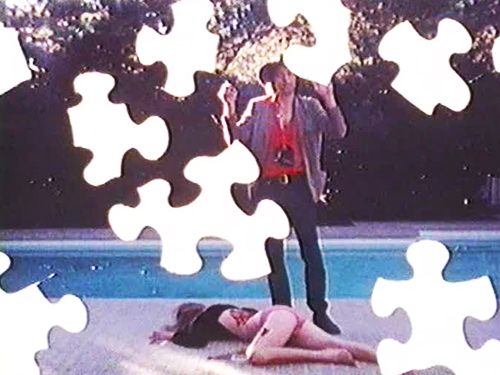
“Jost’s outsider is Frank Goya, a guy with a red shirt, a far-fucking-out-in-the-morning-man delivery, and a fist full of Polaroid snapshots. Ever-cool Goya peers into the camera, announces that he’s a motel-haunting divorce-dick and from then on Angel City is kabuki Raymond Chandler. Hired by the chairman of the world's largest multi-national conglomerate to investigate the death of his wife (a former Plaything centerfold who only ‘came after you hit her’), Goya drives around LA, interviews a bartender, is seduced by the chairman's mistress, solves the case, and gets beat up for his bother.”
Jim Hoberman1
“If Jost can be said to have any mentor at all, it would be Jean-Luc Godard, who supported his work in the early 70s with the statement, ‘He is not a traitor to the movies, like almost all American directors. He makes them move.’ A few European critics such as Peter Wollen have referred to Jost as ‘the American Godard,’ and while none of his work qualifies as strictly imitative – except for Godard 80, a 17-minute interview that deliberately apes Godardian techniques [...] – this provides a useful clue about some of the most salient virtues of Jost’s work: lyricism, sharp political and social criticism inflected by polemics, intellectual cogency informed by philosophical concerns, a sense of abstraction in relation to narrative (including many strategies for distancing the viewer from his plots), stylistic eclecticism, a strong and visible interest in painting and music, and a very formal sense of film construction. One also might compare his most noticeable limitations – an occasional hermeticism and a recurring compulsion to end his films with the gratuitous or absurdist deaths of his heroes (Slow Moves, Rembrandt Laughing, and All the Vermeers in New York) – with those of Godard.”
Jonathan Rosenbaum2
“Angel City [...], shot on 16 mm in 1976 for a budget of $6,000, is part Godardian detective story (with Robert Glaudini as a camera-addressing, bohemian private eye), and part spacey essay on Los Angeles as a place and as an idea. It’s more episodic than narrative: One long chunk of its 76 minutes consists of an infomercial for the corporate mogul whose wife’s death the detective is investigating; another is the wife’s single-shot screen test for big-time director ‘Martin F. Spielkin,’ which consists of a monologue about ‘eating yogurt with Adolf and Eva’: ‘It was the greatest moment of my life – it was a triumph of the will!’ The film’s fiction is threaded together with long, unbroken shots of Los Angeles seen from a moving vehicle, soundtracked by monotonous voices trading off between reciting dry statistics (‘Los Angeles, a city of 5 1/2 million telephones ...’) and equally empty poetic proclamations (‘L.A., city of ghosts, hungers fed by migrant labor...’). The overall tone is bitingly self-reflexive: Late in the game, the detective diffuses the potential pretension by saying to the camera, ‘While you were sort of dreaming about Los Angeles, I was plodding in it for real.’“
Karina Longworth3
- 1Jim Hoberman in the Village Voice
- 2Jonathan Rosenbaum, “A Prophet in His Own Country [Jon Jost retrospective],” jonathanrosenbaum.net, 2018. Originally published in the Chicago Reader, 8 May 1992.
- 3Karina Longworth, “Jon Jost Series at L.A. Filmforum & Cinefamily,” L.A. Weekly, 15 March 2012.

